The Funky Seventies
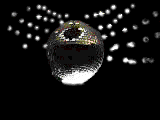
Burn baby burn, disco inferno!
Pop culture goes through a great time of change. Following the turbulence of the
Sixties society shows the after effects with an ever-growing group of Earth Children, a new
Women's Liberation movement and a drug problem that would escalate throughout the
decade. The Vietnam War would not end until a few years into the Seventies while the
wonder of the journey into space would become a more repetitious feat. The decade would
become much more famous though for the disco fad, which in turn would inspire future
artists. For a decade perceived as laid-back and liberated many memorable events would
take place.

Music
Fashion
Art
Television
Movies
Counter-Culture

The Seventies saw some of the great bands of the Sixties split up, make a successful
come-back and seemingly disappear off the face of the Earth. When the Beatles broke up
each member went solo with John going avant-garde and Paul joining Wings with wife
Linda, thereby continuing his commercial success of previous years. The Who, Jefferson
Airplane/Starship, The Rolling Stones and CCR would all keep their huge fan base
throughout the Seventies while bubblegum pop stars such as the Monkees would break up.
With the arrival of three new genres of music-funk, punk and disco, an entirely new
assortment of music superstars would take front stage.
The year of 1970 witnessed the untimely deaths of Sixties music stars Jimi Hendrix
followed closely (within weeks) by Janis Joplin. The next year would see the mysterious
death of Doors' frontman Jim Morrison while in 1977 the King of Rock 'n' Roll, Elvis
Presley, would succumb to a drug overdose which in turn would begin a following and
mourning the world had never seen before. During the early to mid '70's the music had a
country-rock feel and nobody did it better than Lynard Skynard. This band, named after a
gym teacher, had many hits but when disaster struck, as in an airplane crash, the band
would never again be the same. Other stars of this time were Fleetwood Mac, Three Dog
Night, The Doobie Brothers, The Jacksons, Wings, Eagles, Boston and Led Zepplin.
The Seventies music scene went through many changes and throughout the years became
more and more flashier. Prior to disco Glam Rock was very popular; the goal was to look
almost asexual and bright! Captain Fantastic, Ziggy Stardust, The Glimmer Twins and Kiss
all were the epitome of Glam Rock Stars. Elton John, aka Captain Fantastic, was as
popular for his outlandish fashion styles of leisure suits, bizarre glasses and huge platforms
as he was for his music. When David Bowie (Ziggy Stardust) burst onto the scene he
immediately caused a stir with his colourful make-up and clothes as for his bisexuality.
The Glimmer Twins (Mick Jagger and Keith Richards) were too a part of the Glam Rock
scene, but Mick was fulfilled the part of an asexual rocker much more than Keith! Perhaps
the greatest known glam rock band of the Seventies was KISS. The band garbed
themselves in spandex unitards, white and black face paints, huge spiked platforms and
completed the statement with the ultra-long tongue of Gene Simmons.
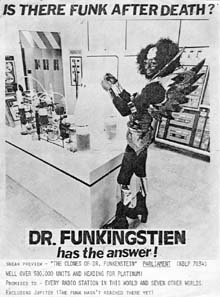 Around the middle of the decade funk began to
become popular with the most well-known band being Parliament Funk. Bootsy, George
and the gang were also well known for their onstage antics but their '78 release "One
Nation Under a Groove" is now seen as one of the best funk albums of all time. Along
with funk disco too became hugely popular. Kool and the Gang, Donna Summer, Le Chic,
K.C. and the Sunshine Band, The Village People, and the Bee Gees, among countless
others, were a major part of the disco craze in the late '70's. The Saturday Night Fever
soundtrack became one of the most popular soundtracks of all time and the disco dance
craze goes in full force.
Around the middle of the decade funk began to
become popular with the most well-known band being Parliament Funk. Bootsy, George
and the gang were also well known for their onstage antics but their '78 release "One
Nation Under a Groove" is now seen as one of the best funk albums of all time. Along
with funk disco too became hugely popular. Kool and the Gang, Donna Summer, Le Chic,
K.C. and the Sunshine Band, The Village People, and the Bee Gees, among countless
others, were a major part of the disco craze in the late '70's. The Saturday Night Fever
soundtrack became one of the most popular soundtracks of all time and the disco dance
craze goes in full force.
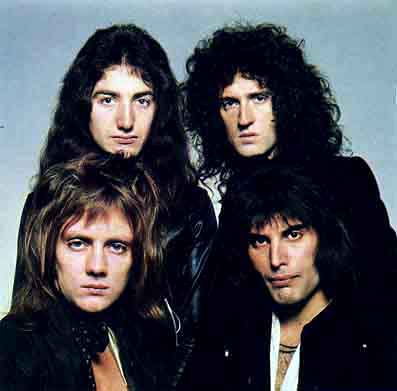 Punk began in Britain in the latter half of the
decade and the poster boy for the music was Johnny Rotten and the band Clash though
Alice in Chains, Ozzy Osbourne, The Velvet Undergournd,Black Sabbath, The Sex
Pistols, Alice Cooper and Iggy Pop all too were a part of the punk/heavy rock
movement.
Punk began in Britain in the latter half of the
decade and the poster boy for the music was Johnny Rotten and the band Clash though
Alice in Chains, Ozzy Osbourne, The Velvet Undergournd,Black Sabbath, The Sex
Pistols, Alice Cooper and Iggy Pop all too were a part of the punk/heavy rock
movement.
Throughout all of the music styles of the Seventies some artists were huge sellers and are
recognized now as some of the most famous artists of the decade. Among them Queen,
Genesis, Marvin Gaye, Barry White, Rod Stewart, Stevie Wonder, Bob Marley, Earth,
Wind and Fire, Blondie, Bob Seger, and Elvis Costello all sold a lot of records and gained
an equal amount of respect.
Some information on the countless number of Seventies bands can be found
at:
Lynard Skynard
P-Funk
Elton John
Queen
David Bowie
Disco
Punk
Women of Punk

In the early 1970's the clothing has an ethnic, hippie feel and clothes seem to become
used for more decoration purposes while the face, body and hair are all coloured in wild
colours to add to the overall effect. The clothing cuts are more natural and women seem to
dress like either gypsies or Native Americans. Skirts are long, hair is wispy and painted
necklaces are worn. Denim bellbottoms and sneakers are being worn by younger kids. By
1971 a craze for dressing up like in the '40's and '50's is becoming extremely popular while
a country-feel with flowing gingham dresses and clogs has also taken hold of women. In
the cities women are wearing hotpants even to the office, T-shirts with printed words,
platform shoes, fishnet tights, puff-sleeve blouses and lots of make up. Yet other women
are wearing plaid, tweed suits or patchwork vests. Crochet is extremely popular and girls
are buying everything from sweaters to crochet bikinis. In 1972 every assortment of
sweater, especially those with sailor motifs, are all the rage while platforms get higher and
wedge-heels and corksoled sandals can also be seen on women. For the summer of '72
loose trousers, huge straw hats, sunglasses, wedge-heels and halter tops can be seen
everywhere. Designers such as Mary Quant, Biba, Chloe and Bill Blass are all popular with
more young women.
With the huge variety of clothing in the early years of the decade, it seemed natural that by
the mid-seventies each piece of clothing looked as though it was picked separately. It is not
unnatural to see skirts, blouses and jackets all of different fabrics, styles and patterns paired
together. Long wool jackets with elastic waists, berets and long hair are also becoming the
uniform clothing of women young to old. The use of ornamental gold and silver on
clothing is quickly brought to an end in 1973 when the world-wide oil shortage
begins.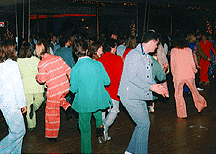 Throughout '73 and '74 another nostalgia
craze for Twenties fashion takes hold, most likely due to the craze of the movie "The Great
Gatsby" and the resulting clothes include ankle-strap heels, knee-length pleated skirts and
fur-trimmed jackets.
Throughout '73 and '74 another nostalgia
craze for Twenties fashion takes hold, most likely due to the craze of the movie "The Great
Gatsby" and the resulting clothes include ankle-strap heels, knee-length pleated skirts and
fur-trimmed jackets.
In 1975 the big look is in and women are told that "much too big is the right size." The
following year Punk is beginning to influence fashion, which originates from London
youths and the streets. While the real underground punks sport spiked heels, spiked hair,
black leather, gothic accessories and geometric make-up, haute couture incorporates a
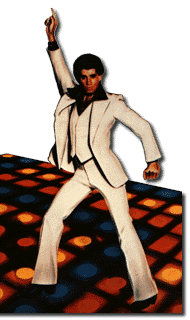 bit of the Punk craze with new black collections
and some Punk-like accessories.
bit of the Punk craze with new black collections
and some Punk-like accessories.
From 1976 to 1979 designers incorporated Middle Eastern and folk costume influences
into their collections and the punk look so popular in 1976 becomes a couple years later
more romanticized with ruffles, crinolines, ribbons and heavy amounts of jewelry worn by
women. Men have been sporting leisure suits, bellbottoms, plaid suits and high-heeled
shoes throughout the decade. With the disco craze club-goers can be seen dancing in
flowing dresses, hot pants, bellbottoms, huge platforms, T-shirts, bright make-up and yards
of polyester are worn! By the end of the Seventies, after a decade of many variations and
styles of clothing, no particular style is considered the "in" thing and consequently
designers such as Yves Saint Laurent, Ralph Lauren, Albert Caprero, Oscar de la Renta,
Thierry Mugler and Claude Montana each go their own way into the Eighties.
Some Seventies fashion links are:
Fashion of the
Seventies
Seventies Fad
Fashions

By the Seventies, a new sense of reality was beginning to
show up in art. For example, in the late 70's an art piece called "Rape" was created which
consisted
of a collage of newspaper articles and photographs about the rape while the hi-tech
computer graphic
technology was being employed for a more futuristic approach. Superrealism was the new
type of
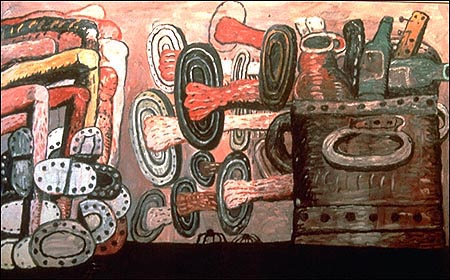 Seventies art and an airbrush was used for
the effect. Artists such as Alan Aldridge and Jean-Jacques Maquaire used
the technique though there was a controversy over whether it was really art. The decade
really had
an eclectic mix of inspirations-everything from art nouveau, to art deco, to nostalgia and to
nudity and sex was the basis of exhibits. The bright colours, psychedelics and drug culture
of the Sixties contributed
to the art of the Seventies and that, along with a new social awareness from everything to
pollution
to abortion brought art heavily into the mainstream. The term "kitsch" was applied to art,
and was
a very good term to describe the hectic and diverse styles of the decade as well as a type of
art
where anything and anyone was commercially exploited to its fullest potential; plastic
ashtrays and garden
gnomes were two examples of the fad. As always, art reflected the times of the day and
when the Punk
movement gained momentum a new sort of pop art became popular with the youth crowd.
Kids turned themselves
into art; they made sculptures of their hair, wore clothes with newspaper articles printed on
them,
pierced themselves with safety pins, tattooed their skin and painted their faces in shocking,
bright
colours. Art had almost seem to come full circle with the youth ten years earlier who had
been
using their bodies for an art easel to the youth presently doing the same thing all in a
rebellious
act in anarchy and freedom.
Seventies art and an airbrush was used for
the effect. Artists such as Alan Aldridge and Jean-Jacques Maquaire used
the technique though there was a controversy over whether it was really art. The decade
really had
an eclectic mix of inspirations-everything from art nouveau, to art deco, to nostalgia and to
nudity and sex was the basis of exhibits. The bright colours, psychedelics and drug culture
of the Sixties contributed
to the art of the Seventies and that, along with a new social awareness from everything to
pollution
to abortion brought art heavily into the mainstream. The term "kitsch" was applied to art,
and was
a very good term to describe the hectic and diverse styles of the decade as well as a type of
art
where anything and anyone was commercially exploited to its fullest potential; plastic
ashtrays and garden
gnomes were two examples of the fad. As always, art reflected the times of the day and
when the Punk
movement gained momentum a new sort of pop art became popular with the youth crowd.
Kids turned themselves
into art; they made sculptures of their hair, wore clothes with newspaper articles printed on
them,
pierced themselves with safety pins, tattooed their skin and painted their faces in shocking,
bright
colours. Art had almost seem to come full circle with the youth ten years earlier who had
been
using their bodies for an art easel to the youth presently doing the same thing all in a
rebellious
act in anarchy and freedom.
Some of links to art of the Seventies can be found at:
American Visions
Art
Conceptual Art
Pop
Art

From the beginning to mid-seventies a retro 1950's trend was a strong force in pop
culture and
two shows were created which were set in this decade-"Happy Days" and "Laverne and
Shirley". Though not
a comedy, the drama "M*A*S*H*" was also set in the 50's during the Korean War. This
show would go on
to become one of the most-watched and most-beloved shows in television history.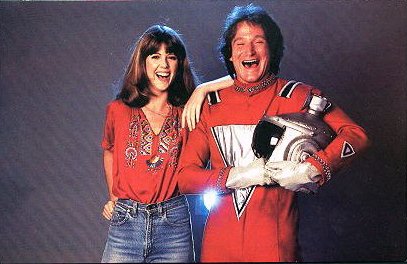 Also remembered fondly
by many viewers was the controversial comedy "All in the Family" which centered around
the bigot
Archie Bunker, his wife, his daughter and his son-in-law affectionately nicknamed
Meathead! The show
was the first to have a toilet flush on network television and became wildly popular for its
total
non-existent political correctness. Also a comedy was "The Mary Tyler Moore" show
which, like "That Girl"
from the 1960's, starred an independent and career-oriented woman who worked for a
news show. The comedy's
most talked-about episode was the one in which a clown had passed on, which everybody
found hilarious and Mary
didn't, that is until she saw the humour of it at the funeral where by that time everyone else
had quit
laughing! "Rhoda" was a spin-off of the show and this time was centered on Mary's loud
and out-going
best friend. The 70's would also be known for creating many more oddball comedies such
as "Mork and Mindy"
which had a young Robin Williams starring as an alien living with a human woman and
wearing rainbow
suspenders! "The Partridge Family" was a music-comedy show and had a family singing
their troubles away
while traveling in a bright, psychedelic bus which Mom drove! Another family show, "The
Brady Bunch",
gained popularity from the decade before and would become known as almost a
representation of the Seventies in all
its cheesy glory! Kids had their own shows too with "Sesame Street", "Scooby Doo",
"Wonder Woman" and the resurrection of an
animated "Star Trek" which featured the voices of the Star Trek Crew and horrible
animation!
Also remembered fondly
by many viewers was the controversial comedy "All in the Family" which centered around
the bigot
Archie Bunker, his wife, his daughter and his son-in-law affectionately nicknamed
Meathead! The show
was the first to have a toilet flush on network television and became wildly popular for its
total
non-existent political correctness. Also a comedy was "The Mary Tyler Moore" show
which, like "That Girl"
from the 1960's, starred an independent and career-oriented woman who worked for a
news show. The comedy's
most talked-about episode was the one in which a clown had passed on, which everybody
found hilarious and Mary
didn't, that is until she saw the humour of it at the funeral where by that time everyone else
had quit
laughing! "Rhoda" was a spin-off of the show and this time was centered on Mary's loud
and out-going
best friend. The 70's would also be known for creating many more oddball comedies such
as "Mork and Mindy"
which had a young Robin Williams starring as an alien living with a human woman and
wearing rainbow
suspenders! "The Partridge Family" was a music-comedy show and had a family singing
their troubles away
while traveling in a bright, psychedelic bus which Mom drove! Another family show, "The
Brady Bunch",
gained popularity from the decade before and would become known as almost a
representation of the Seventies in all
its cheesy glory! Kids had their own shows too with "Sesame Street", "Scooby Doo",
"Wonder Woman" and the resurrection of an
animated "Star Trek" which featured the voices of the Star Trek Crew and horrible
animation!
Britain had some terrific comedies of their own, one being the hugely successful "The
Monty Python Show" which
was in essence a collection of skits of live action coupled with some very cool animation. In
the mid-Seventies,
the show "Are You Being Served?" began a long-run and featured some of the funniest
and perverse
characters to grace television screens. The show was centered around employers in the
Grace Brothers
department store who were constantly struggling to find some common ground to like each
other. And in between
there were some great song and dance numbers with the flamboyant Mr. Humphries! An
Canadian version
of the skit comedy show was SCTV, a hit on both sides of the border and starred many of
the future "Saturday Night Live"
cast. "Saturday Night Live" would be the only show to survive the decade and is still being
aired
presently, itself inspiring shows.
Dramas and cop shows of the Seventies left a memorable history in television. From "Love
Boat" to
"Columbo" a viewer had a taste of all sorts of situations. 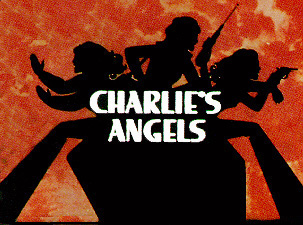 Reflecting the Woman's Movement cop shows
which had women as the aggressors were also wildly popular, though they were probably
made so by
the males who had crushes on these cops! The arguably famous of them all was "Charlie's
Angels" which made
a star out of Farrah Fawcett (that combined with her now-legendary poster) and featured
three crime-fighting
women. "Starsky and Hutch" was another cop show but this time had a woman following
with the dreamy Det. Kenneth Hutchinson and his handsome partner Det. David Starsky
and it too has become almost cult-like with its
following. Two other famous cop shows of the decade were "Kojak" and "CHIPS" which
had highway
cops and a great intro music piece!
Reflecting the Woman's Movement cop shows
which had women as the aggressors were also wildly popular, though they were probably
made so by
the males who had crushes on these cops! The arguably famous of them all was "Charlie's
Angels" which made
a star out of Farrah Fawcett (that combined with her now-legendary poster) and featured
three crime-fighting
women. "Starsky and Hutch" was another cop show but this time had a woman following
with the dreamy Det. Kenneth Hutchinson and his handsome partner Det. David Starsky
and it too has become almost cult-like with its
following. Two other famous cop shows of the decade were "Kojak" and "CHIPS" which
had highway
cops and a great intro music piece!
Legendary shows such as "The Ed Sullivan Show" and "The Johnny Carson" show
continued throughout some and
most of the decade. The game show "The Price is Right" also began its run and even today
is a very
popular hour on television.
Some of the numerous shows of the Seventies can be found at:
Seventies
Shows
All in the Family
Starsky and
Hutch
Charlie's Angels
Love Boat
Are You Being Served?
SCTV
Scooby Doo
The Brady
Bunch

In the Seventies, careers of stars were rejuvenated, others were wiped out and some
were created-Jack Nicholson
was one whose career really took off in the beginning years of the decade. Movies like
"Five Easy Pieces" (1970), "Carnal Knowledge" (1971),
"The Last Detail" (1973) and "Chinatown" (1974) are all now-classic movies but the one
performance which really stands out
for Nicholson and one of his most remembered movies is "One Flew Over the Cuckoo's
Nest" (1975) in which he played Randle P. McMurphy who
feigns madness and is sent to a mental institute where he makes a point of breaking all of
the rules while at the same times acquiring
respect from the real patients. The movie would go on to win every major award at the
Academy Awards that year, including Best Picture and Best Actor.
Marlon Brando's career had gone downhill since the Sixties but that would change after he
made the controversial "Last Tango in Paris" (1972) which in turn
lead to a memorable role as Don Vito Corleone in "The Godfather" (1972) and as Kurtz in
the 1979 "Apocalypse Now", a movie which costarred Martin Sheen as a man sent on a
journey through
the wilds of Vietnam to find and "exterminate with extreme prejudice" Kurtz, who
supposedly had gone mad. The movie itself was extremely difficult
to make because of reports of over-budgeting, clashes between crew and Sheen suffered a
heart attack during the filming. Another film set during
the Vietnam war was "The Deer Hunter" (1978) which included a cast of Robert De Niro,
Christopher Walken and Meryl Streep. The movie was about the story of
three close friends who are sent to Vietnam and there they are exposed to the insanity of
war and are forced to deal with it their own way. De Niro becomes the
rock in the story and, in a very famous scene at the end, confronts his now demented
friend (Walken) during a Russian roulette bet. Streep would go on to star in "Kramer vs.
Kramer" (1979) with Dustin Hoffman.
Horror movies of the Seventies became cult-like in their following. "The Exorcist" (1973)
and "Carrie" (1976) each featured a female character
who had either become possessed or very, very angry and wants to get revenge! Although
not your typical horror movie, rather a spoof of 50's sci-fi movies,
"The Rocky Horror Picture Show" (1975) was infamous for its audience participation,
which included rice-throwing and screaming out obscenities
whenever certain characters appeared. 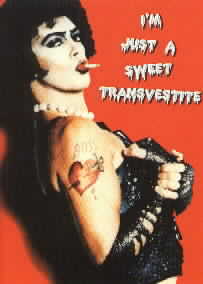 Tim Curry
starred as the "sweet transvestite" while a young Susan Sarandon sang and starred as the
yuppie-turned vamp Janet. (Dammit!)
Tim Curry
starred as the "sweet transvestite" while a young Susan Sarandon sang and starred as the
yuppie-turned vamp Janet. (Dammit!)
The biggest movie to come out of the Seventies was "Star Wars" (1977), a story about a
young adventurer named Luke Skywalker who, along with Hans Solo, Princess Leia,
Chewbacca, R2-D2 and C3PO, is out
to travel to the Death Star to stop Darth Vader from misusing the dark powers. The movie
was the first of a trilogy, but actually part six in the whole series and it
spawned a huge business with collectors.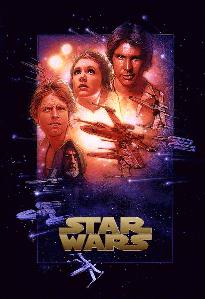 Other
large movies of the Seventies was "Rocky" (1976) starring Sylvester Stallone as a boxer,
and "Grease" (1978) and "Saturday Night Fever" (1977) both which
starred John Travolta. Sci-fi movies such as "Alien" (1979), "Superman" (1978), "Close
Encounters of the Third Kind" (1977) and "Star Trek" series all were a part of a 1950's
legacy of UFO's and comic
strips. The first X-rated cartoon, "Fritz the Cat" (1973) would feature a pot-smoking,
inner-city, sexually liberated cat who goes on an adventure of such. "Shaft" would become
the big, black private dic with a killer theme sung by Issac Hayes.
Steven Speilberg would direct "Jaws" (1975) about a killer shark and it too became a
blockbuster of the Seventies.
Other
large movies of the Seventies was "Rocky" (1976) starring Sylvester Stallone as a boxer,
and "Grease" (1978) and "Saturday Night Fever" (1977) both which
starred John Travolta. Sci-fi movies such as "Alien" (1979), "Superman" (1978), "Close
Encounters of the Third Kind" (1977) and "Star Trek" series all were a part of a 1950's
legacy of UFO's and comic
strips. The first X-rated cartoon, "Fritz the Cat" (1973) would feature a pot-smoking,
inner-city, sexually liberated cat who goes on an adventure of such. "Shaft" would become
the big, black private dic with a killer theme sung by Issac Hayes.
Steven Speilberg would direct "Jaws" (1975) about a killer shark and it too became a
blockbuster of the Seventies.
Some excellent and famous movies of the Seventies didn't necessarily feature star-studded
casts and big budgets. John Belushi, of SNL fame, starred in the 1978 comedy "Animal
House" as Bluto Blutarsky,
the character that most people associate Belushi with. "Love Story" (1970), "A Clockwork
Orange" (1971), "Klute" (1971), "The French Connection" (1971), "Cabaret" (1972) "The
Sting" (1973), "American Graffiti" (1973), "Taxi Driver" (1976), "Annie Hall" (1977),
"Pretty Baby" (1978) and "10" (1979) were all
dramas from the Seventies, many of which won Academy Awards for best picture, along
with bringing forth the issues of the day.
Information about Seventies movies and actors/actresses can be found at:
Internet Movie Database (1970-
1979)
Academy Award Movies of the
Seventies
Star Wars
Jaws
Grease
Jack Nicholson
Marlon
Brando
Meryl
Streep
Johh Belushi
Jane
Fonda

The hippies of the Sixties became the Earth Children of the Seventies. Those who
had not dropped the hippie lifestyle by the Seventies went
on to live in communes and live off the land throughout the Seventies. Protests against the
Vietnam War were still cropping up throughout America (who would not pull out of the
war until 1975),the most famous being the Kent State antiwar demonstrators
who were gunned down by the National Guard, killing four in 1970. All around the world
new issues were being brought to the consciousness
of people which demanded attention. Starting in 1970 women rallied nationwide and
a new protest for feminism began to gain in popularity. Gloria Steinem was a famous and
controversial icon of the feminist
movement and was the editor and founder of Ms. Magazine, a magazine promoting
feminist rights. Steinem would become the leader
of the National Organization of Women while bringing to attention other causes
such as Native American rights. Germaine Greer, also a supporter
of feminist rights, wrote "The Female Eunich" in 1971 and too became an icon of feminist
rights of the decade.
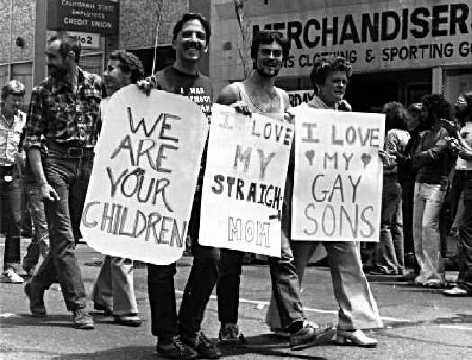 By 1971, homosexual rights were also
being brought to the forefront of society. Protests were held all across
the world in order for homosexuals to gain recognition and equality of their lifestyles.
Parades became
a common practice for gays and lesbians which, if not at least for notoriety, forced people
to hear
about the trials for human justice.
By 1971, homosexual rights were also
being brought to the forefront of society. Protests were held all across
the world in order for homosexuals to gain recognition and equality of their lifestyles.
Parades became
a common practice for gays and lesbians which, if not at least for notoriety, forced people
to hear
about the trials for human justice.
New environmental protests in which
everything from nuclear waste to pollution, was demonstrated by activists. Continuing on
from decades before, the fight for equal black rights surged ahead. Angela Davies was a part of this fight and embodied all the defiance and pride that took the struggle from the 60's on in to the 70's.
Beginning from the late Sixties, a new type of black culture would emerge. Blaxploitation
films, with such stars as the foxy Pam Grier and wise-cracking Richard Roundtree,
became hits with all groups of people. A new type of person, within a 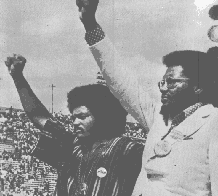 funk culture, was a black person
who embraced his/her heritage with pride and has commonly been described, as a positive
expression for the
essence of the black struggle for equality which blossomed into the freedom of the
Seventies. Artists such as
George Clinton, Michael Jackson and Rick James became symbols of the funk culture. The
funk culture strayed
away from the violent protests of years before and instead encouraged younger generations
to be proud
of themselves and their culture. Also by the Seventies the number of black entertainers
and artists
in the film and music industry increased and the shock of seeing interracial couples on and
off screen
was becoming much more accepted than as compared to the decades beforehand.
funk culture, was a black person
who embraced his/her heritage with pride and has commonly been described, as a positive
expression for the
essence of the black struggle for equality which blossomed into the freedom of the
Seventies. Artists such as
George Clinton, Michael Jackson and Rick James became symbols of the funk culture. The
funk culture strayed
away from the violent protests of years before and instead encouraged younger generations
to be proud
of themselves and their culture. Also by the Seventies the number of black entertainers
and artists
in the film and music industry increased and the shock of seeing interracial couples on and
off screen
was becoming much more accepted than as compared to the decades beforehand.
Another very new culture was beginning in Britain, and by 1976 would become noticed to
the mainstream society. This was the punk culture which also had its roots in the Sixties but
did not
gain momentum until the Seventies. The typical punk supported anarchy and had a
working-class background
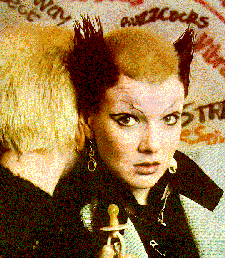 with an accent and language to match.
Punk embraced hard rock music and kitsch art; fashion was
to the extremes and completely opposite to that of "normal" society. The punk culture
immediately
got a backlash and was thought to be an evil phenomenon that took young kids and made
them into violent,
hard-drug taking anarchists with no sense of structure; these kids were much more
outspoken and rough
than their hippie counterparts from the Sixties and Beats from the Fifties. Rockers like the
Sex Pistols, who declared
themselves to be Queen-hating anarchists and the poetess Patti Smith were definite icons of
the punk culture; the culture, like
funk, had its own magazines, music, clothes and movies. And too, like funk, would
continue on in to the next decade with a new
generation of supporters and followers.
with an accent and language to match.
Punk embraced hard rock music and kitsch art; fashion was
to the extremes and completely opposite to that of "normal" society. The punk culture
immediately
got a backlash and was thought to be an evil phenomenon that took young kids and made
them into violent,
hard-drug taking anarchists with no sense of structure; these kids were much more
outspoken and rough
than their hippie counterparts from the Sixties and Beats from the Fifties. Rockers like the
Sex Pistols, who declared
themselves to be Queen-hating anarchists and the poetess Patti Smith were definite icons of
the punk culture; the culture, like
funk, had its own magazines, music, clothes and movies. And too, like funk, would
continue on in to the next decade with a new
generation of supporters and followers.
When the disco fad reached its zenith by the late 70's it had already turned into a semi-
culture. With so many
other music types happening in the decade, the disco craze had its devout followers and
passionate haters. What the disco
culture had in common with the punk culture was the connection with hard drugs. The
marijuana and LSD of the Sixties turned
into the heroin and cocaine of the Seventies. Jimi Hendrix and Janis Joplin were early
fatalities to drugs that would
turn many people into addicts (such as Eric Clapton and Keith Richards) and either kill
them (like Sid Vicious) or ruin their lives. The late Seventies, on a whole, could be
summed up
in one word-liberation. Sex and drugs were very commonplace and as a result of it STD's
became a mini-epidemic while the
crackdown on drugs and its repercussion became much more harsh than ever before. The
birth control advice of the Sixties in
magazines became the diaphragm advice of the Seventies. With the very last of the Baby
Boomers reaching their teens and a whole
new generation cropping up, the end of a cynical, hectic and puzzled decade came to a
climax which would
mellow into the Eighties.
Some great links to counter-culture material on the Seventies can be found
at:
Funk-Black Culture
Blaxploitation
Gay Parades of the Seventies
Bisexual/Homosexual History
History of Women's Liberation
The Feminist
Chronicles-Year by Year

This page was created by Polyester Pam-text ©1998.
All pictures used came from
various pages, and the places where they came from should have a link to that page under
the section that they're used.
To get credit for the pictures, to supply information, to correct me, or to send suggestions
send them here.
Find your own outta-site way back!
This page was most dy-no-mite-ly hosted by 
Get your own far-out Free Home Page
| 

 Around the middle of the decade funk began to
become popular with the most well-known band being Parliament Funk. Bootsy, George
and the gang were also well known for their onstage antics but their '78 release "One
Nation Under a Groove" is now seen as one of the best funk albums of all time. Along
with funk disco too became hugely popular. Kool and the Gang, Donna Summer, Le Chic,
K.C. and the Sunshine Band, The Village People, and the Bee Gees, among countless
others, were a major part of the disco craze in the late '70's. The Saturday Night Fever
soundtrack became one of the most popular soundtracks of all time and the disco dance
craze goes in full force.
Around the middle of the decade funk began to
become popular with the most well-known band being Parliament Funk. Bootsy, George
and the gang were also well known for their onstage antics but their '78 release "One
Nation Under a Groove" is now seen as one of the best funk albums of all time. Along
with funk disco too became hugely popular. Kool and the Gang, Donna Summer, Le Chic,
K.C. and the Sunshine Band, The Village People, and the Bee Gees, among countless
others, were a major part of the disco craze in the late '70's. The Saturday Night Fever
soundtrack became one of the most popular soundtracks of all time and the disco dance
craze goes in full force. Punk began in Britain in the latter half of the
decade and the poster boy for the music was Johnny Rotten and the band Clash though
Alice in Chains, Ozzy Osbourne, The Velvet Undergournd,Black Sabbath, The Sex
Pistols, Alice Cooper and Iggy Pop all too were a part of the punk/heavy rock
movement.
Punk began in Britain in the latter half of the
decade and the poster boy for the music was Johnny Rotten and the band Clash though
Alice in Chains, Ozzy Osbourne, The Velvet Undergournd,Black Sabbath, The Sex
Pistols, Alice Cooper and Iggy Pop all too were a part of the punk/heavy rock
movement. Throughout '73 and '74 another nostalgia
craze for Twenties fashion takes hold, most likely due to the craze of the movie "The Great
Gatsby" and the resulting clothes include ankle-strap heels, knee-length pleated skirts and
fur-trimmed jackets.
Throughout '73 and '74 another nostalgia
craze for Twenties fashion takes hold, most likely due to the craze of the movie "The Great
Gatsby" and the resulting clothes include ankle-strap heels, knee-length pleated skirts and
fur-trimmed jackets. bit of the Punk craze with new black collections
and some Punk-like accessories.
bit of the Punk craze with new black collections
and some Punk-like accessories. Seventies art and an airbrush was used for
the effect. Artists such as Alan Aldridge and Jean-Jacques Maquaire used
the technique though there was a controversy over whether it was really art. The decade
really had
an eclectic mix of inspirations-everything from art nouveau, to art deco, to nostalgia and to
nudity and sex was the basis of exhibits. The bright colours, psychedelics and drug culture
of the Sixties contributed
to the art of the Seventies and that, along with a new social awareness from everything to
pollution
to abortion brought art heavily into the mainstream. The term "kitsch" was applied to art,
and was
a very good term to describe the hectic and diverse styles of the decade as well as a type of
art
where anything and anyone was commercially exploited to its fullest potential; plastic
ashtrays and garden
gnomes were two examples of the fad. As always, art reflected the times of the day and
when the Punk
movement gained momentum a new sort of pop art became popular with the youth crowd.
Kids turned themselves
into art; they made sculptures of their hair, wore clothes with newspaper articles printed on
them,
pierced themselves with safety pins, tattooed their skin and painted their faces in shocking,
bright
colours. Art had almost seem to come full circle with the youth ten years earlier who had
been
using their bodies for an art easel to the youth presently doing the same thing all in a
rebellious
act in anarchy and freedom.
Seventies art and an airbrush was used for
the effect. Artists such as Alan Aldridge and Jean-Jacques Maquaire used
the technique though there was a controversy over whether it was really art. The decade
really had
an eclectic mix of inspirations-everything from art nouveau, to art deco, to nostalgia and to
nudity and sex was the basis of exhibits. The bright colours, psychedelics and drug culture
of the Sixties contributed
to the art of the Seventies and that, along with a new social awareness from everything to
pollution
to abortion brought art heavily into the mainstream. The term "kitsch" was applied to art,
and was
a very good term to describe the hectic and diverse styles of the decade as well as a type of
art
where anything and anyone was commercially exploited to its fullest potential; plastic
ashtrays and garden
gnomes were two examples of the fad. As always, art reflected the times of the day and
when the Punk
movement gained momentum a new sort of pop art became popular with the youth crowd.
Kids turned themselves
into art; they made sculptures of their hair, wore clothes with newspaper articles printed on
them,
pierced themselves with safety pins, tattooed their skin and painted their faces in shocking,
bright
colours. Art had almost seem to come full circle with the youth ten years earlier who had
been
using their bodies for an art easel to the youth presently doing the same thing all in a
rebellious
act in anarchy and freedom. Also remembered fondly
by many viewers was the controversial comedy "All in the Family" which centered around
the bigot
Archie Bunker, his wife, his daughter and his son-in-law affectionately nicknamed
Meathead! The show
was the first to have a toilet flush on network television and became wildly popular for its
total
non-existent political correctness. Also a comedy was "The Mary Tyler Moore" show
which, like "That Girl"
from the 1960's, starred an independent and career-oriented woman who worked for a
news show. The comedy's
most talked-about episode was the one in which a clown had passed on, which everybody
found hilarious and Mary
didn't, that is until she saw the humour of it at the funeral where by that time everyone else
had quit
laughing! "Rhoda" was a spin-off of the show and this time was centered on Mary's loud
and out-going
best friend. The 70's would also be known for creating many more oddball comedies such
as "Mork and Mindy"
which had a young Robin Williams starring as an alien living with a human woman and
wearing rainbow
suspenders! "The Partridge Family" was a music-comedy show and had a family singing
their troubles away
while traveling in a bright, psychedelic bus which Mom drove! Another family show, "The
Brady Bunch",
gained popularity from the decade before and would become known as almost a
representation of the Seventies in all
its cheesy glory! Kids had their own shows too with "Sesame Street", "Scooby Doo",
"Wonder Woman" and the resurrection of an
animated "Star Trek" which featured the voices of the Star Trek Crew and horrible
animation!
Also remembered fondly
by many viewers was the controversial comedy "All in the Family" which centered around
the bigot
Archie Bunker, his wife, his daughter and his son-in-law affectionately nicknamed
Meathead! The show
was the first to have a toilet flush on network television and became wildly popular for its
total
non-existent political correctness. Also a comedy was "The Mary Tyler Moore" show
which, like "That Girl"
from the 1960's, starred an independent and career-oriented woman who worked for a
news show. The comedy's
most talked-about episode was the one in which a clown had passed on, which everybody
found hilarious and Mary
didn't, that is until she saw the humour of it at the funeral where by that time everyone else
had quit
laughing! "Rhoda" was a spin-off of the show and this time was centered on Mary's loud
and out-going
best friend. The 70's would also be known for creating many more oddball comedies such
as "Mork and Mindy"
which had a young Robin Williams starring as an alien living with a human woman and
wearing rainbow
suspenders! "The Partridge Family" was a music-comedy show and had a family singing
their troubles away
while traveling in a bright, psychedelic bus which Mom drove! Another family show, "The
Brady Bunch",
gained popularity from the decade before and would become known as almost a
representation of the Seventies in all
its cheesy glory! Kids had their own shows too with "Sesame Street", "Scooby Doo",
"Wonder Woman" and the resurrection of an
animated "Star Trek" which featured the voices of the Star Trek Crew and horrible
animation! Reflecting the Woman's Movement cop shows
which had women as the aggressors were also wildly popular, though they were probably
made so by
the males who had crushes on these cops! The arguably famous of them all was "Charlie's
Angels" which made
a star out of Farrah Fawcett (that combined with her now-legendary poster) and featured
three crime-fighting
women. "Starsky and Hutch" was another cop show but this time had a woman following
with the dreamy Det. Kenneth Hutchinson and his handsome partner Det. David Starsky
and it too has become almost cult-like with its
following. Two other famous cop shows of the decade were "Kojak" and "CHIPS" which
had highway
cops and a great intro music piece!
Reflecting the Woman's Movement cop shows
which had women as the aggressors were also wildly popular, though they were probably
made so by
the males who had crushes on these cops! The arguably famous of them all was "Charlie's
Angels" which made
a star out of Farrah Fawcett (that combined with her now-legendary poster) and featured
three crime-fighting
women. "Starsky and Hutch" was another cop show but this time had a woman following
with the dreamy Det. Kenneth Hutchinson and his handsome partner Det. David Starsky
and it too has become almost cult-like with its
following. Two other famous cop shows of the decade were "Kojak" and "CHIPS" which
had highway
cops and a great intro music piece! Tim Curry
starred as the "sweet transvestite" while a young Susan Sarandon sang and starred as the
yuppie-turned vamp Janet. (Dammit!)
Tim Curry
starred as the "sweet transvestite" while a young Susan Sarandon sang and starred as the
yuppie-turned vamp Janet. (Dammit!) Other
large movies of the Seventies was "Rocky" (1976) starring Sylvester Stallone as a boxer,
and "Grease" (1978) and "Saturday Night Fever" (1977) both which
starred John Travolta. Sci-fi movies such as "Alien" (1979), "Superman" (1978), "Close
Encounters of the Third Kind" (1977) and "Star Trek" series all were a part of a 1950's
legacy of UFO's and comic
strips. The first X-rated cartoon, "Fritz the Cat" (1973) would feature a pot-smoking,
inner-city, sexually liberated cat who goes on an adventure of such. "Shaft" would become
the big, black private dic with a killer theme sung by Issac Hayes.
Steven Speilberg would direct "Jaws" (1975) about a killer shark and it too became a
blockbuster of the Seventies.
Other
large movies of the Seventies was "Rocky" (1976) starring Sylvester Stallone as a boxer,
and "Grease" (1978) and "Saturday Night Fever" (1977) both which
starred John Travolta. Sci-fi movies such as "Alien" (1979), "Superman" (1978), "Close
Encounters of the Third Kind" (1977) and "Star Trek" series all were a part of a 1950's
legacy of UFO's and comic
strips. The first X-rated cartoon, "Fritz the Cat" (1973) would feature a pot-smoking,
inner-city, sexually liberated cat who goes on an adventure of such. "Shaft" would become
the big, black private dic with a killer theme sung by Issac Hayes.
Steven Speilberg would direct "Jaws" (1975) about a killer shark and it too became a
blockbuster of the Seventies. By 1971, homosexual rights were also
being brought to the forefront of society. Protests were held all across
the world in order for homosexuals to gain recognition and equality of their lifestyles.
Parades became
a common practice for gays and lesbians which, if not at least for notoriety, forced people
to hear
about the trials for human justice.
By 1971, homosexual rights were also
being brought to the forefront of society. Protests were held all across
the world in order for homosexuals to gain recognition and equality of their lifestyles.
Parades became
a common practice for gays and lesbians which, if not at least for notoriety, forced people
to hear
about the trials for human justice. funk culture, was a black person
who embraced his/her heritage with pride and has commonly been described, as a positive
expression for the
essence of the black struggle for equality which blossomed into the freedom of the
Seventies. Artists such as
George Clinton, Michael Jackson and Rick James became symbols of the funk culture. The
funk culture strayed
away from the violent protests of years before and instead encouraged younger generations
to be proud
of themselves and their culture. Also by the Seventies the number of black entertainers
and artists
in the film and music industry increased and the shock of seeing interracial couples on and
off screen
was becoming much more accepted than as compared to the decades beforehand.
funk culture, was a black person
who embraced his/her heritage with pride and has commonly been described, as a positive
expression for the
essence of the black struggle for equality which blossomed into the freedom of the
Seventies. Artists such as
George Clinton, Michael Jackson and Rick James became symbols of the funk culture. The
funk culture strayed
away from the violent protests of years before and instead encouraged younger generations
to be proud
of themselves and their culture. Also by the Seventies the number of black entertainers
and artists
in the film and music industry increased and the shock of seeing interracial couples on and
off screen
was becoming much more accepted than as compared to the decades beforehand. with an accent and language to match.
Punk embraced hard rock music and kitsch art; fashion was
to the extremes and completely opposite to that of "normal" society. The punk culture
immediately
got a backlash and was thought to be an evil phenomenon that took young kids and made
them into violent,
hard-drug taking anarchists with no sense of structure; these kids were much more
outspoken and rough
than their hippie counterparts from the Sixties and Beats from the Fifties. Rockers like the
Sex Pistols, who declared
themselves to be Queen-hating anarchists and the poetess Patti Smith were definite icons of
the punk culture; the culture, like
funk, had its own magazines, music, clothes and movies. And too, like funk, would
continue on in to the next decade with a new
generation of supporters and followers.
with an accent and language to match.
Punk embraced hard rock music and kitsch art; fashion was
to the extremes and completely opposite to that of "normal" society. The punk culture
immediately
got a backlash and was thought to be an evil phenomenon that took young kids and made
them into violent,
hard-drug taking anarchists with no sense of structure; these kids were much more
outspoken and rough
than their hippie counterparts from the Sixties and Beats from the Fifties. Rockers like the
Sex Pistols, who declared
themselves to be Queen-hating anarchists and the poetess Patti Smith were definite icons of
the punk culture; the culture, like
funk, had its own magazines, music, clothes and movies. And too, like funk, would
continue on in to the next decade with a new
generation of supporters and followers.